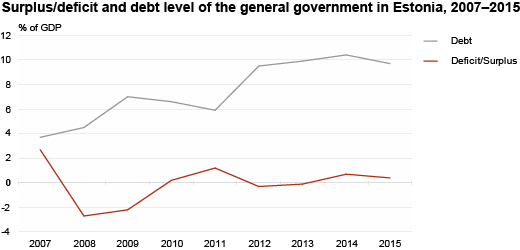General government balance continued in surplus
According to the preliminary data of Statistics Estonia, in 2015, the Estonian general government surplus was 0.4% and the gross debt level was 9.7% of the gross domestic product.
At the end of 2015, the total revenues of the general government exceeded the expenditures by 84.1 million euros, accounted as the Maastricht deficit criteria. By the end of 2015, the surplus of revenues of the central government sub-sector was 12.7 million euros. The consolidated budget of the local government sector was 47.6 million euros in surplus. The budget surplus of social security funds was 23.9 million euros, which is considerably smaller than in previous years.
The consolidated debt of the general government (Maastricht debt) amounted to 2 billion euros by the end of 2015, having fallen 4% compared to 2014. The local governments as well as the central government contributed to the fall of the debt level. At the end of 2015, the debt of the central government sub-sector totalled 1.4 billion euros and the local governments’ debt accounted for 0.7 billion euros. As in previous periods, social security funds did not contribute to the debt of the general government sector.
The loan liabilities of the central government decreased by 4% and the volume of long-term securities issued by the public-legal institutions and foundations belonging to the central government decreased by 6%. The share of foreign debt in the central government’s loan liabilities was 85%.
The Estonian involvement in the European temporary rescue mechanism, EFSF (European Financial Stability Facility) decreased by 30 million euros in 2015. At the end of 2015, liabilities towards the EFSF totalled 454.6 million euros, 79% of which went for the participation in the rescue package for Greece, 12% for Portugal and 9% for Ireland.
The overall debt level of the local governments fell by a little over 3% compared to 2014. While the volume of long-term securities decreased by nearly one-fifth over the year, the liabilities of short-term as well as long-term loans increased. Liabilities towards the rest of the world accounted for nearly 22% of the local governments' debt.In Estonia, the general government sector comprises three sub-sectors: 1) central government (state budget units and extra-budgetary funds, foundations, legal persons in public law); 2) local governments (city and rural municipality governments with their subsidiary units, foundations); 3) social security funds (Estonian Health Insurance Fund, Estonian Unemployment Insurance Fund).
Eurostat is going to publish the data on the preliminary debt and deficit levels of the Member States on 21 April.
